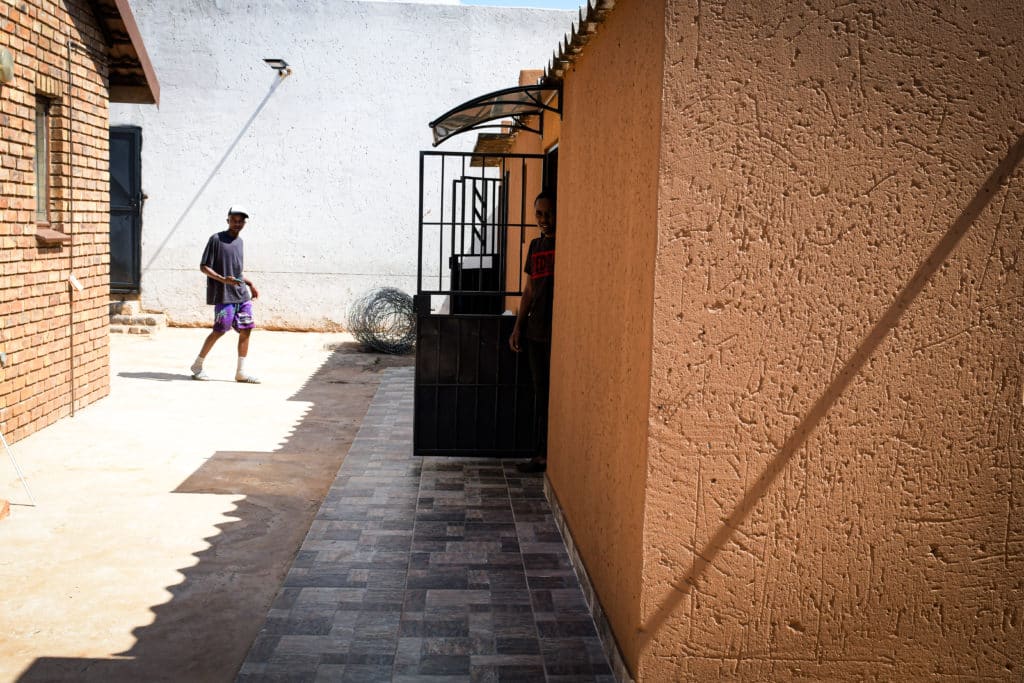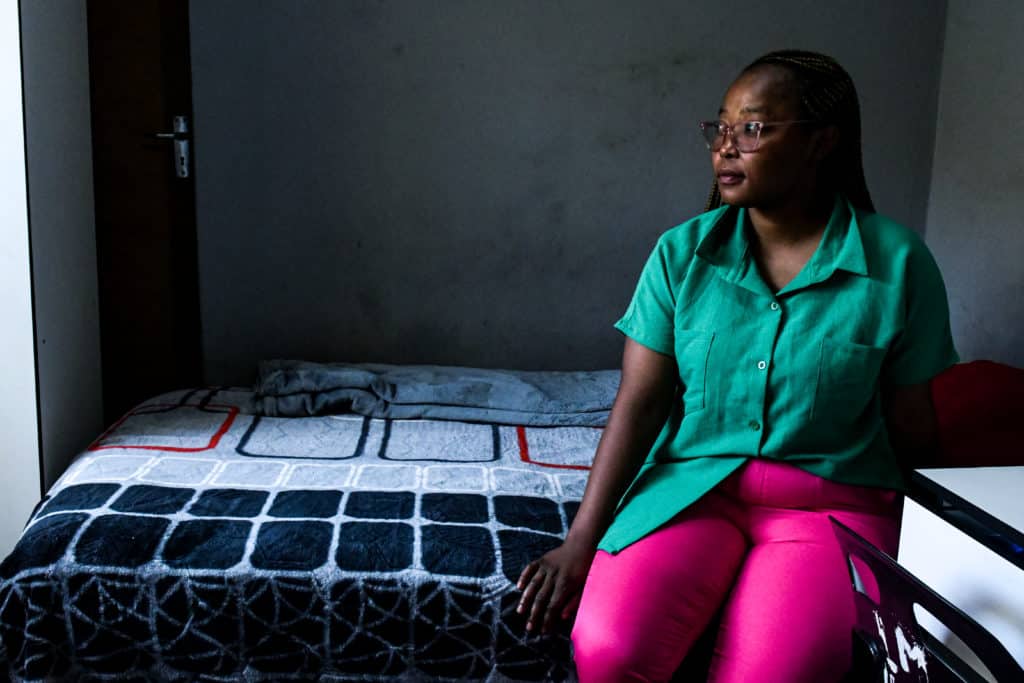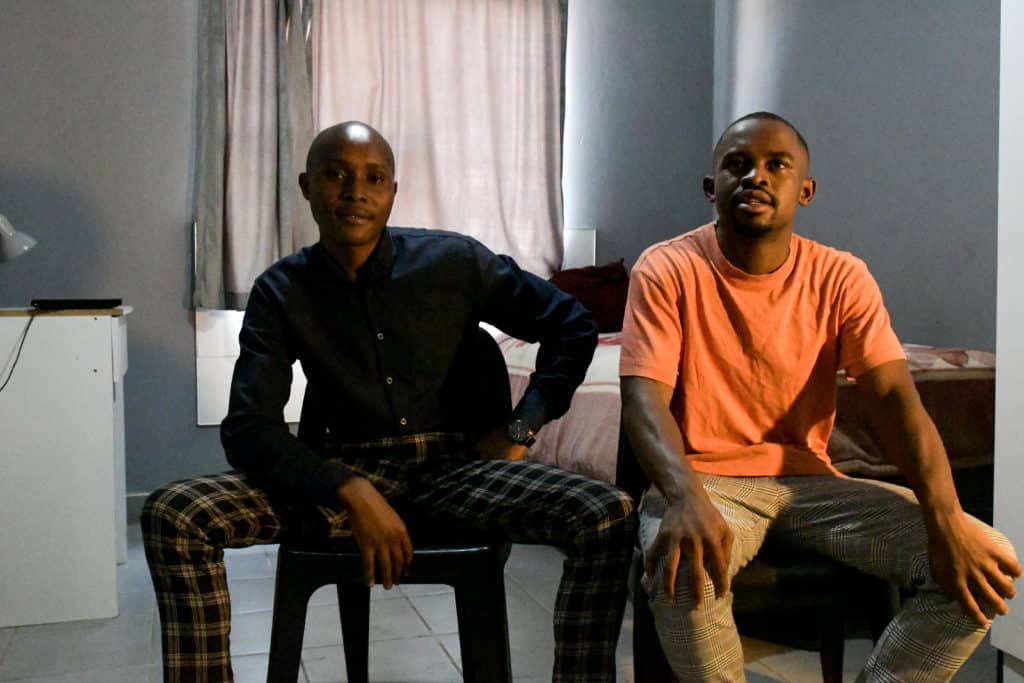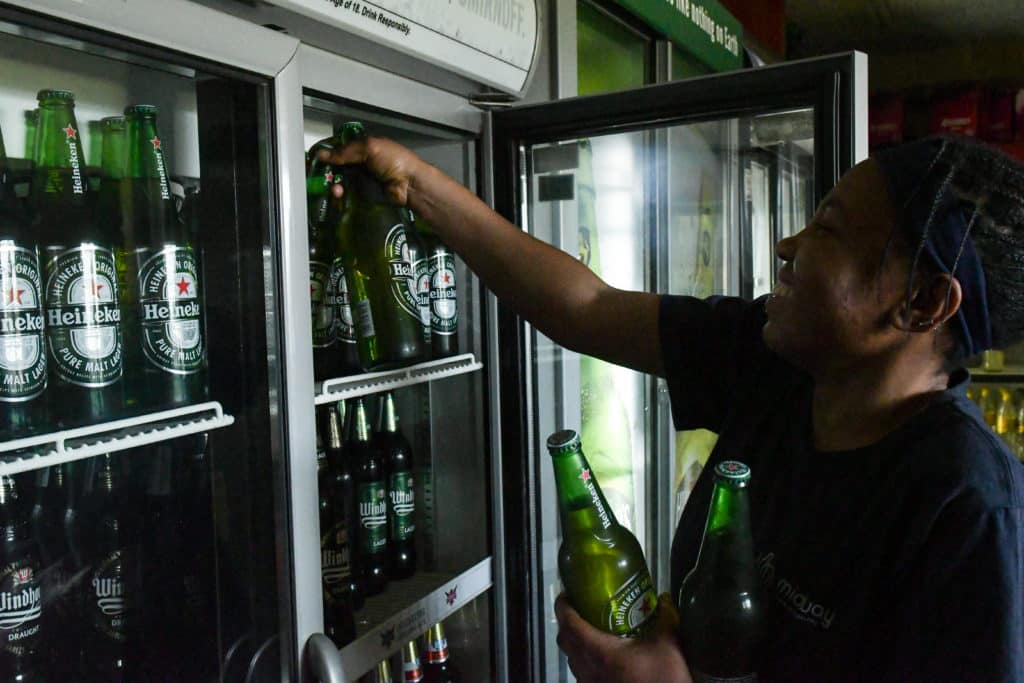There’s an intimate story on these pages. Of life in Johannesburg’s suburban sprawls; the moody and mighty townships that thrive from dawn to dusk, bearing within them the dreams and secrets of a city on its way up, never failing to look at itself, into its beaten soul and the great backstories of survival. The billion-dollar-plus backyard rental industry is one such, making room for hope and dignity where there often is none.
It’s a big reality, the ubiquitous yet mostly-under-the-radar ‘backroom rental market’ in South Africa’s informal economy.
And it’s a big answer to a bleak issue – limited housing.

“WE HAVE A LOT OF DATA ABOUT OUR ECONOMY BUT VERY LITTLE ABOUT THE TOWNSHIP ECONOMY. MY ARGUMENT IS THAT THE INFORMAL BUSINESS SECTOR IS ABOUT R750 BILLION ($41 BILLION).”
— GG Alcock, author
Add to that the unlimited problems of unemployment, poor government service delivery and consistent rolling blackouts that cast long shadows of despair.
But there is an unspoken language of resilience or sub-text in these economies.
Where the system fails, there is room for creativity, literally, and therein exists a billion-dollar rental market for ‘the room in the back’.
According to a 2022 report by financial services provider Rand Merchant Bank, this market is neither taxed nor monitored by the government. Although this is cause for concern, Roger Wilco’s 2022 Township CX Report states that the sector’s total market value is estimated to be R900 billion ($48 billion) with approximately 60% of the market considered formal and 40% informal. Over R20 billion ($1 billion) of that is the backyard rental market space.

“I think it’s potentially double that, but let’s just stick with R20 billion; over and above that there is another R25 billion ($1.3 billion) a year earned from spaza (shop) rentals,” GG Alcock, the South African author of KasiNomics, says to FORBES AFRICA.
KasiNomics emerged as a book from the insights, practices, and case studies of the township economy. “And here is the thing, if someone comes to you and asks you if you are unemployed, you are going to say ‘yes’ but meanwhile you are renting out a backroom for let’s say R9,000 (tax- free) ($480) but you will still say you are unemployed.” The idea of the sector is also rapidly changing, says Bulelani Balabala, a township entrepreneur-developer and founder of Township Entrepreneurs Alliance.
“Traditionally, backrooms were situated [in the back],” Balabala says. “And the back part of the house was not seen. And ideally, then, in a normal standard compound or house, you would have anywhere between two to about five of these backrooms.”
Literally, behind-the-scenes and not formalized.
But the concept is clearly gaining ground as price-conscious tenants are now seeking out backrooms that are well-built, nicely- furnished, and come with trappings suchas Wi-Fi, even generators to ward off the country’s rampant load shedding blues. The more modern, the more the cost. All that adds up – to billion-dollar figures.

Teko Motlhabi, the founder and CEO of Roomsta Backyard Rentals, a digital platform aimed at connecting landlords and prospective tenants, says that number is “a drop in the ocean” considering the size of the population in South Africa’s townships.
In a country of over 62 million people, there are over 500 townships that are home to approximately 11.6 million people.
Motlhabi hypothesizes that the contribution of the backroom rental market could at least be in trillions.

“I PERSONALLY LIKE MY TENANTS TO HAVE THEIR PRIVACY.” — Nthabiseng Sejake, who owns multiple backroom rentals across Soweto
But there is no data to help support this. Alcock agrees. “We have a lot of data about our economy but very little about the township economy. My argument is that the informal business sector is about R750 billion ($41 billion),” he explains. “Now how much data do we have of that? We have got a reasonable amount, but not the same as the formal sector. So the first thing that people do is they ask, ‘where’s the data’?”
This, however, does not stop the ‘hustle’ for making ends meet. Take Nthabiseng Sejake, who owns multiple backroom rentals across Soweto, an urban township in South Africa’s Gauteng province. She ventured into this as a registered “side hustle”, after being a tenant herself of a backroom in her earlier days, and wanted to set the perception right.

“SOUTH AFRICA IS DESIGNED [IN A WAY] THAT PEOPLE DO NOT LIVE WHERE THEY WORK.” —Teko Motlhabi, founder and CEO,
Roomsta Backyard Rentals
“I had just started working, and lived in one of those backrooms where there were about four of us sharing a bathroom which wasn’t hygienic,” Sejake recalls. “There was also this idea of a boundary where you were only allowed in your room and nowhere else. The rent at the place at the time was R1,003 ($53).”
The average monthly rent of residential properties increased across all provinces in South Africa in 2021, except for the Free State and Gauteng.
According to StatsSA, in the final quarter of the year, the national average rent stood at approximately R7,900 ($420) a month.

In the informal sector, the backrooms cost anywhere between R2,000 ($107) to R4,000 ($214).
It’s a more affordable alternative, providing roofs over the heads of those wanting to stretch the rand, and save up.
Sejake drove this writer to her three backroom properties (varying in price) across Soweto, hoping to also break the stereotype about what a backroom in iKasi (township) actually looks like.
BREAKING PERCEPTIONS
The most common impression about backrooms is that they are not sanitary and that dozens of people share tiny, secluded spaces.
“There is nothing like that,” Motlhabi counters. “You can’t say [such places] don’t exist but it is not the predominant thing in South Africa.”

“You will never find more than two people in these rooms,” Alcock offers. “One of the biggest perceptions is the assumption that people who live in townships are all poor. And yes, of course, there are poor people, according to StatsSA, 11% of our households live on the breadline. That’s about two million households, but there are 16 million that don’t.”
“I personally like my tenants to have their privacy,” Sejake says to us as we walk into her Pimville property.
Back at her Protea Glen property in Soweto, where Sejake also lives, most of her tenants say they experience a sense of community.
“I FEEL SAFE HERE AND THAT WAS VERY IMPORTANT TO ME,” — Mogau Mabula, a student at the University of Johannesburg

The sunny Sunday spring afternoon in November when we visit, Anelisa Lubambo, Shoki Masethe and Thabo ‘Mr Party’ Buthelezi are seated in the courtyard of the property drinking ciders and listening to loud RnB music from the early 2000s.
There is laughter, banter, and general merriment. Sejake joins in too, recounting the memories of the last two years since most of the tenants moved in. “She [Sejake] respects us and vice versa,” Lubambo admits. “She does not have this perception that ‘you guys are tenants and I’m the landlord’. She does not think she is better than us, which is what I like about living here.”
Security and safety are also determinants for the students residing in her properties. Her homes are equipped with alarm systems, locked security gates, and caretakers. For Masethe, who lives here with her 16-year-old daughter, safety was a crucial consideration. She moved from Auckland Park, a more upscale suburb. “Auckland Park was closer to work, but the rent was too expensive,” says Lubambo, who also moved from there. “When I came to Soweto, I also had the perception that there is crime and all that, but it’s now my third year here and I feel safe.”
University of Johannesburg student, Mogau Mabula, who lives in Sejake’s Pimville property, shares the same sentiment. “I do feel safe here and that was very important to me. It was a huge concern when I had to choose. I don’t like places where there are a lot of people.”
These living arrangements are also often inclusive.

Anna Mothapo, for example, lived in Polokwane in South Africa’s Limpopo province before she moved to Sejake’s Protea Glen residence. On account of her hearing disability, she had faced multiple harrowing experiences in her previous home, but not here, she says. She now lives amongst people who respect her and also hang out with her in the courtyard.
Mothapo is preparing lunch as Sejake walks into her room. “Anna is the best cook here,” Sejakes signs to Mothapo, as she erupts in laughter.
HOME FOR YOUNG PROFESSIONALS
The idea of the backroom actually goes back to the apartheid years in South Africa when segregation was the norm – white people were allowed to own land and houses, but this was not so for people of color. The Native Urban Areas Act of 1923 passed in South Africa made it obligatory for black Africans to reside in designated locations, people perpetually paid rent for government-built housing, lived in single-sex hostels, or illegally built shelters with materials they could find (as per a report on AlJazeera).
“You had black people living in certain areas, white people living in certain areas,” Motlhabi says. “The black areas were small, and people wanted to live in places close to work opportunities. South Africa is designed [in a way] that people do not live where they work. Particularly black people don’t live where they work. So they had to travel.
There are countless academic reports and research papers positing that the remnants of the apartheid era can still be seen in South Africa’s housing sector. A new report by Harvard’s Growth Lab identifies two broad classes of problems that undermine inclusive growth across South Africa: collapsing state capacity and spatial exclusion; with the researchers finding that structures of spatial exclusion “have been inadvertently entrenched through well-intentioned post-apartheid housing policies”.
“And because of that, certain areas like Soweto, Tembisa, Alexandra, and Khayelitsha [in the Western Cape]; are a bit closer to work opportunities. But they got crowded over time as people migrated to come and look for work. That gave birth to the backroom market.”
For a transient, fleeting population, this provided the best or only options.
“The places overly saturated with backrooms are within Gauteng,” Balabala explains. “Gauteng is the economic hub of the country. But within Gauteng, you look at primarily high-activity areas like Mamelodi or Tembisa, Soweto or Diepsloot. Especially when you consider [that] even when foreign nationals come into the country, those are the places they land up in. And those are the places closest to certain economic zones.”

This has also been a boon for young professionals aspiring for better lives but at prices that don’t break the bank.
Take Percy Siphamandla Ndlovu. As an entrepreneur running a small business, living in a backroom gives him the financial flexibility to pursue his passion until he is ready to settle down one day. “I have been here four years now,” says Ndlovu, who also dabbles in stock trading and is a driver for an e-hailing service. “Living here is nice because Nthabi (Sejake) and I get to bond over business.”
Another resident, Ndaba Nzima, also living far away from his home in coastal KwaZulu-Natal, is a student of civil engineering at the University of Johannesburg. He misses his grandfather back home but thankfully, here in the big city, has found a “brother” in his roommate Kabelo Molefe. “And we have only been roommates for a year,” says Nzima, attesting to the bond he shares with the people at the property.
MORE DIGITAL, MORE DATA, LESS REGULATION, MORE DIGNIFIED LIVING
Reports indicate that while the market may be informal and unregulated, there is significant structure and complexity to it. The township economy itself, even with its vast significance and size, is heavily underestimated. And one of the crucial factors making it difficult are the regulations.

A North-West University study in 2017 states that South African politicians are often hesitant in their endorsement and acceptance of informal rentals. “This is the case given the possible backlash due to the constant and liberal promises made to provide dignified human settlements for all,” the report reads.
According to Alcock, the restrictions placed on backroom rentals need a different blueprint than what you would typically find in a sectional title rental in suburban areas like Morningside or Weltevreden Park. He applauds acts such as the Gauteng Township Economic Development Bill implemented last year. The act seeks to facilitate and promote inclusive economic growth along a transformative paradigm to build a cohesive and more equal society underpinned by: a growing and inclusive economy that harnesses the potential of all people in the republic who reside in Gauteng.
“The thing is the rules that are out there, the bylaws, they were made for London in 1800,” Alcock observes. “We’ve just adopted them… This is the problem in a modern society and economy, we are still trying to stick to rules that shouldn’t apply to modern society.
“If we want to be so strict with rental and building regulations, does the government feel that they’re going to be able to build enough units to house people or are they saying people must live in shacks? Because those are the only options [for some].”
The current system of backyard rental provisions, or lack thereof, is constrained by various factors. These include financial and legislative impediments in the context of massive housing shortages, backlogs, and unrealistic expectations. “This is why the biggest conversation that we need to be having around the backroom model is to say,” Balabala adds, “if it’s such a big contributor to the economy, and can help the government in creating more dignified living, then some of these legislations and some of the policies need to be changed from a municipal perspective.”

“IF IT’S SUCH A BIG CONTRIBUTOR TO THE ECONOMY, AND CAN HELP THE GOVERNMENT IN CREATING MORE DIGNIFIED LIVING, THEN SOME OF THESE LEGISLATIONS AND SOME OF THE POLICIES NEED TO BE CHANGED FROM A MUNICIPAL PERSPECTIVE.” —Bulelani Balabala, founder of Township Entrepreneurs Alliance
The truth is in your face: everywhere you drive around in these townships, you see people have built backrooms abutting their homes as a stable secondary (sometimes even primary) source of income. “Everywhere you look,” Sejake says pointing to these ubiquitous adjuncts, “you see backrooms, and they are not always used just for accommodation.”
According to Alcock’s KasiNomics, the backroom rental industry is estimated to generate over R50 billion ($2.6 billion) per annum, as owners rent out their rooms for accommodation, storage, corner shops (spazas), garages, takeaways, workshops, hair salons, beauty parlors, and other services.

According to 2016 statistics by the Department of Human Settlements, rough estimates show there were about one million backroom rental units with the average estimated rental about R2,500 ($137) per unit a month. The department has also stated that the backroom economy has both positive and negative implications. On the positive side, Nozipho Zulu, the department’s Chief Director, Communications, says it provides income and livelihood opportunities for individuals who would otherwise be unemployed or underemployed. It also contributes to the availability of goods and services in underserved areas.
“However, the backroom economy also presents challenges,” Zulu adds. “It operates outside the purview of government regulations, making it difficult to enforce labor laws, ensure worker protection,
and collect taxes. This can perpetuate inequality, hinder economic growth, and limit the government’s ability to provide public services and social safety nets.”
“We receive about 700 searches a day,” says Roomsta’s Motlhabi, citing a demand and supply issue. “But it’s still a drop in the ocean, compared to how big this market is; if you had to take all these townships into consideration. And to me, it’s disheartening because we cannot fill even half of those numbers in terms of the supply (the backroom) because there really is a lack of supply.”

“You’ve got the individual who just wants a living space,” Balabala adds. “It doesn’t matter what it looks like, the big boom is happening as a result of those looking for decent living space in better living conditions. And they’re willing to pay for that.” And willing they are.
The township economy, specifically spaza shops, contributes at least 5.2% to South Africa’s Gross Domestic Product (GDP).
According to a 2019 report by Gauteng Township Economy Revitalisation Strategy, the government is committed to ensure that the township economy contributes at least 30% of Gauteng province’s GDP by 2030.
“This is where the money is, in the townships,” Alcock says. “This is where people go shopping. This is where they socialize. Taverns are incredibly upmarket today. Fast food is a huge thing and people buy it because they prefer it. Whether that’s a kota or chicken dust or shisanyama, it’s not because it’s cheaper… It’s because people prefer these things.
“[What we are] trying to [do is] change people’s mindsets about what townships are. They’re not these places of misery and low economic activity. They’re actually vibrant, exciting, economically- active places, and in many ways represent the future of economic activity.”
